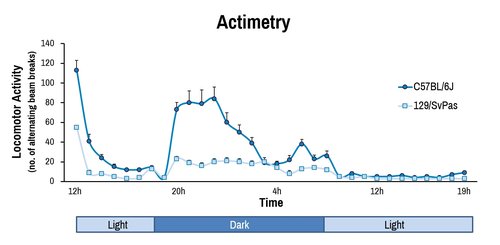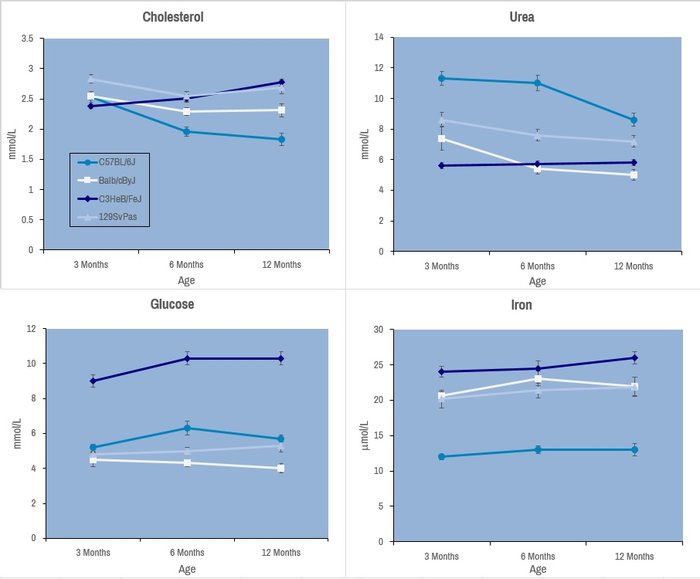
I agree Our site saves small pieces of text information (cookies) on your device in order to deliver better content and for statistical purposes. You can disable the usage of cookies by changing the settings of your browser. By browsing our website without changing the browser settings you grant us permission to store that information on your device.
Dysregulated sleep patterns, induced by overnight work shifts, affect health status in many respects. We provide you with several tests to evaluate and affect circadian rhythms, which is driven by an endogenous clock located in suprachiasmatic nuclei in mammals.
Under constant environmental conditions, mice demonstrate circadian and ultradian periodicity of activity and feeding behavior, which is driven by an endogenous clock located in suprachiasmatic nuclei in mammals.
Measurement of spontaneous activity and food/water intake allows evaluation of biological rhythm and sleep abnormalities.

Strain comparison between C57BL/6J and 129/SvPas over 32 hours with noted hourly measure of locomotor activity. Light and dark phase intervals are noted. Food and water measures are made concurrently.
The measurement of various blood metabolites, ions, and enzymes provides a primary screen for function of major metabolic organs such as kidney, liver, gastrointestinal tract, as well as for lipid and glucose homeostasis.
A panel of parameters is proposed, including:

Selected plasma chemistry data from female mice (N=20 per line) of common laboratory strains at different ages (Champy et al. Mammalian Genome 2008). Error bars reflect ± SEM.
These tests are performed with an AU-480 automated laboratory work station (Beckman Coulter France SAS, Villepinte, France).
Calorimetry cages allow the simultaneous measurement of energy expenditure, ambulatory activity as well as food and water intake. Energy expenditure is evaluated through indirect calorimetry by measuring oxygen consumption with an open flow respirometric system. It also monitors CO2 production, thus the respiratory exchange ratio (RER) and finally heat production can be calculated. Infra-red frames are integrated to the system in order to measure ambulatory activity. A food intake monitoring system is also integrated for the measurement of feeding/drinking behaviors.
Experiments can be performed from 24h to 5 consecutive days.
The test can be conducted at different ambient temperature (4°C to 39 °C) and the cages allow one to performing food and drink restriction procedures as well as food or drink preference assays.
See our Indirect calorimetry dedicated section for more details.
Mice are social creatures and develop in group settings but most learning and behavioral tasks are limited to individual mice. IntelliCages allow cognitive and behavioural evaluation in a social environment using transponder technology, which also drastically reduce human involvement at the time of study.
See our Anatomopathology dedicated page to explore all our available tests.
See our Gene expression analysis dedicated page to explore our different related tests.
See our In vivo Viral Transduction dedicated page to explore our frequently used vectors and delivery modes including stereotactic admininistration (intraventricular and cerebellar)
With several months notice, we can procure and provide a variety of different restriction diets for nutritional analyses in conjuction with our other analyses.
With several months notice, we can procure and provide a variety of different restriction diets for nutritional analyses in conjuction with our other analyses.
See our In vivo Viral Transduction dedicated page to explore our frequently used vectors and delivery modes including stereotactic admininistration (intraventricular and cerebellar)